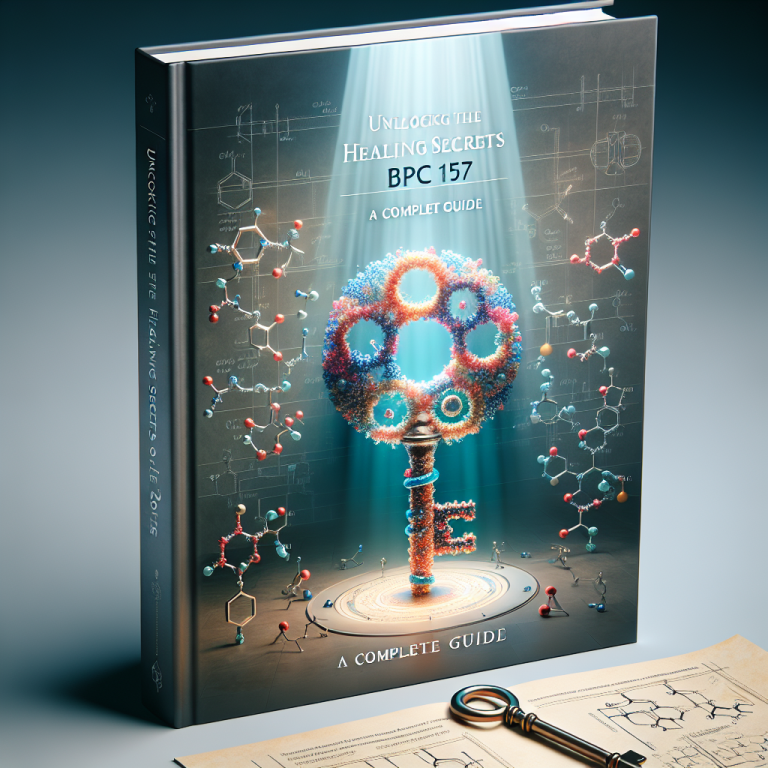Benefits Of BPC 157 For Joint Health And Recovery
BPC 157, a peptide composed of 15 amino acids, has garnered significant attention within the medical and scientific communities for its remarkable potential in promoting joint health and expediting recovery. Derived originally from a protein found in the stomach, BPC 157 is often referred to as “body protection compound,” indicating its profound healing and protective capabilities.
One of the primary benefits of BPC 157 is its ability to enhance the healing processes of the body, particularly in the joints and connective tissues. This makes it a valuable asset for individuals suffering from joint-related conditions such as arthritis or those recovering from joint surgeries. The peptide achieves this by promoting the formation of new blood vessels, a process known as angiogenesis. This increase in blood vessel formation improves blood flow to damaged tissues, which is crucial for delivering nutrients and oxygen needed for healing.
Furthermore, BPC 157 helps in modulating the inflammatory response, which is a vital aspect of the healing process. Inflammation is the body’s natural response to injury or damage, serving to isolate the affected area and prevent further injury. However, excessive inflammation can lead to prolonged pain and delayed healing. By modulating this response, BPC 157 helps in reducing excessive inflammation, thereby alleviating pain and enhancing recovery speed.
Another significant aspect of BPC 157’s action is its impact on collagen. Collagen is a major component of joint cartilage, and its degradation leads to joint problems and decreased mobility. BPC 157 not only promotes collagen formation but also protects existing collagen networks within the body. This dual action supports the structural integrity of joints, reducing the risk of injuries and enhancing the overall functionality of the joint system.
For individuals engaged in high-impact sports or activities that place significant stress on the joints, BPC 157 can be particularly beneficial. It not only aids in quick recovery from injuries but also plays a preventive role by strengthening the joints and connective tissues, thus potentially reducing the incidence of future injuries.
Moreover, BPC 157’s benefits extend beyond joint health. Its regenerative properties have been observed in various types of tissues, including muscle, tendon, and even nervous tissue. This broad spectrum of healing capabilities makes BPC 157 a compound of interest not only for those looking to recover from joint injuries but also for individuals aiming to maintain overall physical health and resilience.
In conclusion, BPC 157 offers a promising avenue for enhancing joint health and recovery. Its ability to improve blood flow, modulate inflammation, promote collagen formation, and protect tissue integrity collectively contribute to its effectiveness. As research continues to unfold, the potential applications of BPC 157 may expand further, offering hope for improved treatment options for a variety of conditions related to joint health and beyond. However, as with any therapeutic intervention, consultation with a healthcare professional is essential to determine the appropriateness and safety of BPC 157 for individual use.
How BPC 157 Enhances Wound Healing And Tissue Repair

BPC 157, a peptide consisting of 15 amino acids, has gained significant attention in the medical and scientific community due to its potent healing properties. This synthetic peptide is derived from a protein found in the stomach and is primarily recognized for its remarkable ability to enhance wound healing and tissue repair. Understanding the mechanisms through which BPC 157 operates can provide insights into its potential therapeutic applications and benefits.
The healing process is complex, involving inflammation, tissue formation, and tissue remodeling. BPC 157 positively influences all these stages, thereby accelerating recovery and promoting tissue health. One of the primary ways in which BPC 157 enhances wound healing is by increasing the formation of blood vessels, a process known as angiogenesis. This is crucial because new blood vessels help supply the necessary nutrients and oxygen to the healing tissue, which is vital for repair and regeneration.
Moreover, BPC 157 has been shown to upregulate growth factors such as VEGF (vascular endothelial growth factor), which plays a pivotal role in both angiogenesis and the synthesis of collagen. Collagen, the most abundant protein in the body, is essential for maintaining the structure and strength of tissues. By promoting collagen formation, BPC 157 not only speeds up the healing of wounds but also ensures that the repair is robust and durable.
Additionally, BPC 157 exhibits anti-inflammatory properties, which are beneficial during the initial phase of wound healing. Inflammation is a natural response to injury; however, excessive inflammation can delay healing and lead to further tissue damage. BPC 157 helps modulate the inflammatory response, reducing excessive inflammation and thus facilitating a more conducive environment for healing. This modulation is achieved through the regulation of various cytokines and mediators involved in the inflammatory process.
The peptide also plays a role in protecting and healing the cells lining the gastrointestinal tract. This is particularly relevant because the integrity of these cells is crucial for preventing complications such as ulcers and other gastrointestinal disorders that can arise from or exacerbate tissue damage.
Furthermore, research indicates that BPC 157 can counteract the effects of certain toxic substances and medications that might impair the healing process. For instance, it has been observed to mitigate the adverse effects of non-steroidal anti-inflammatory drugs (NSAIDs) on the gut lining, thereby preventing potential delays in healing associated with these medications.
Importantly, BPC 157’s ability to enhance wound healing and tissue repair is not limited to soft tissues but extends to bone healing as well. The peptide has been found to improve the healing of bone fractures and ligament injuries, making it a compound of interest not only for general medicine but also for sports medicine and orthopedics.
In conclusion, BPC 157 serves as a powerful agent in promoting wound healing and tissue repair. Its multifaceted approach includes stimulating angiogenesis, enhancing collagen synthesis, modulating inflammation, and protecting against certain toxic effects, all of which contribute to its efficacy. As research continues to unfold, the full potential of BPC 157 could offer promising advances in medical treatments, providing faster and more effective solutions for various types of tissue injuries and conditions.
Exploring The Safety And Dosage Guidelines For BPC 157
Title: Exploring The Safety And Dosage Guidelines For BPC 157
BPC 157, a peptide composed of 15 amino acids, is a synthetic substance derived from a protein found in stomach secretions. It has garnered attention due to its potential healing properties, particularly in tissues like muscles, tendons, and ligaments. Though not yet approved by regulatory bodies such as the FDA for widespread clinical use, BPC 157 holds promise in various therapeutic applications. The peptide is reputed for its fast healing and regenerative capabilities, leading to its popularity in experimental and alternative medicine circles. However, as with any emerging treatment, understanding the safety and appropriate dosage guidelines of BPC 157 is essential for its effective and responsible use.
The safety profile of BPC 157 is a primary concern. Preliminary studies, primarily conducted on animals, have suggested that BPC 157 exhibits high levels of safety. Research indicates that even high doses of the peptide do not typically produce toxic effects. These studies have shown that BPC 157 can significantly enhance the healing processes without significant side effects or toxicity, highlighting its potential as a therapeutic agent. However, it is crucial to note that human trials are sparse, and thus, the extrapolation of these results to humans should be approached with caution.
The dosage of BPC 157 can vary widely depending on the specific condition being treated and the method of administration. The peptide can be administered through injections or orally, the choice of which may affect its efficacy and the required dosage. Injectable forms of BPC 157 are believed to be more effective, particularly for localized injuries in tissues such as tendons or ligaments, due to the direct application to the target area. Oral administration, on the other hand, is generally used for systemic effects, such as improving gastrointestinal health.
Determining the optimal dosage is complicated by the lack of comprehensive clinical data. However, dosages in animal studies have ranged widely, and translating these doses to human equivalents requires careful consideration of differences in metabolism and body size. Anecdotal evidence from experimental users suggests varying dosages, often between 250 mcg to 1 mg per day, tailored according to individual response and the severity of the condition. These dosages, while informative, should be treated with skepticism until more rigorous scientific data is available.
Furthermore, the duration of BPC 157 use also plays a critical role in its safety and efficacy. Short-term use has been observed to be beneficial in both animal studies and anecdotal human reports, with minimal adverse effects. However, the long-term effects of BPC 157 remain largely unknown, necessitating further research to establish a comprehensive safety profile over extended periods.
In conclusion, BPC 157 presents a promising avenue for the treatment of various injuries and conditions due to its potent healing properties. Although initial studies and reports highlight its potential safety and effectiveness, the lack of significant clinical trials means that these findings should be interpreted with caution. Prospective users of BPC 157 should consult healthcare professionals and consider current research to make informed decisions regarding its use. As interest in BPC 157 continues to grow, ongoing and future research will be critical in establishing clear, evidence-based guidelines for its safe and effective administration.

